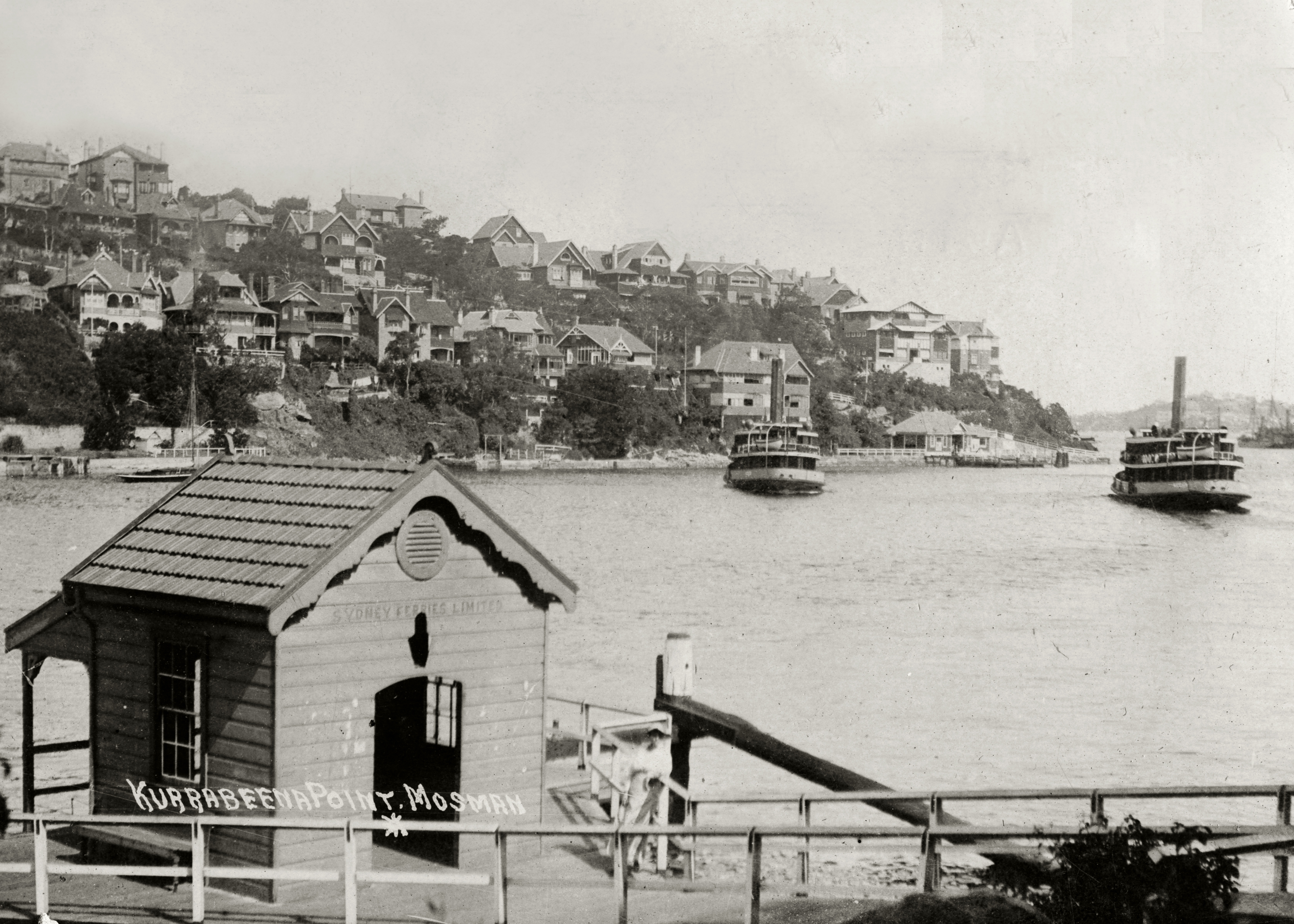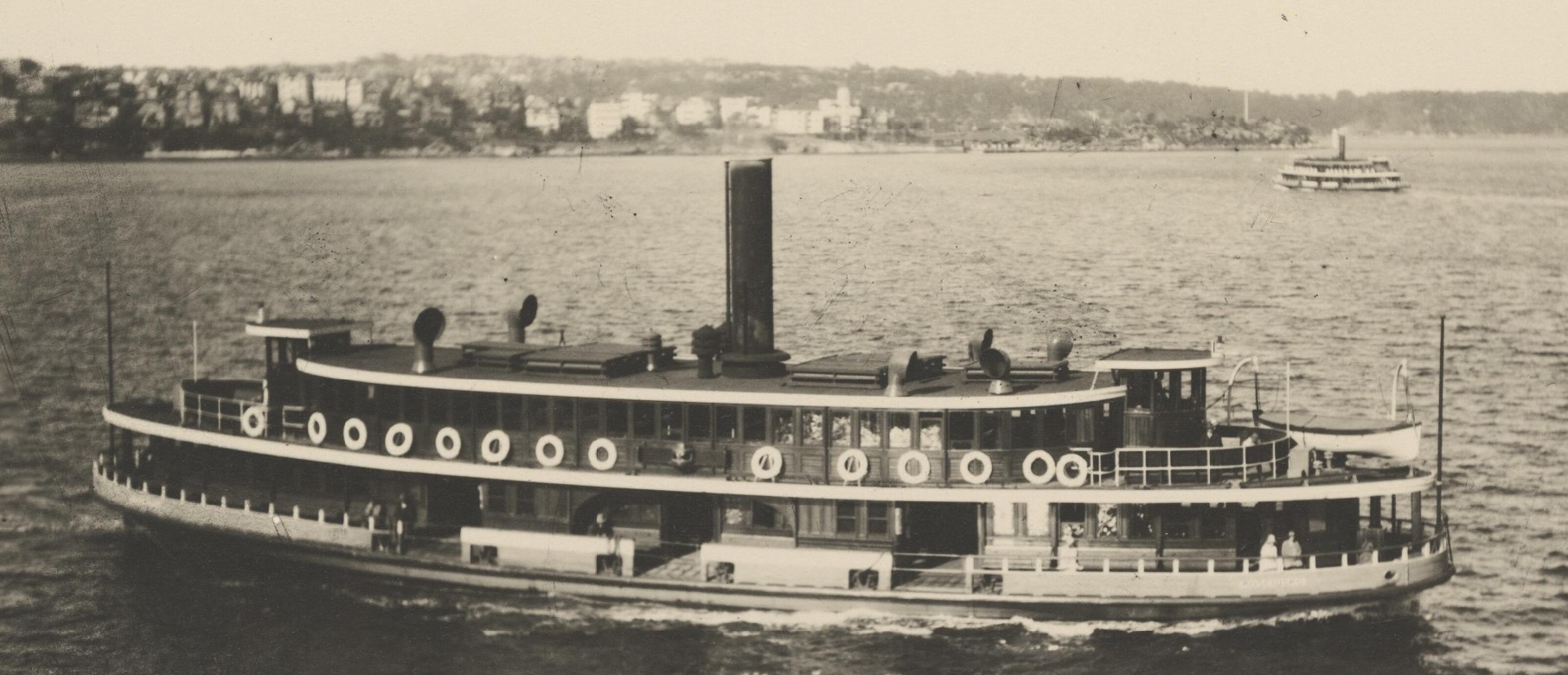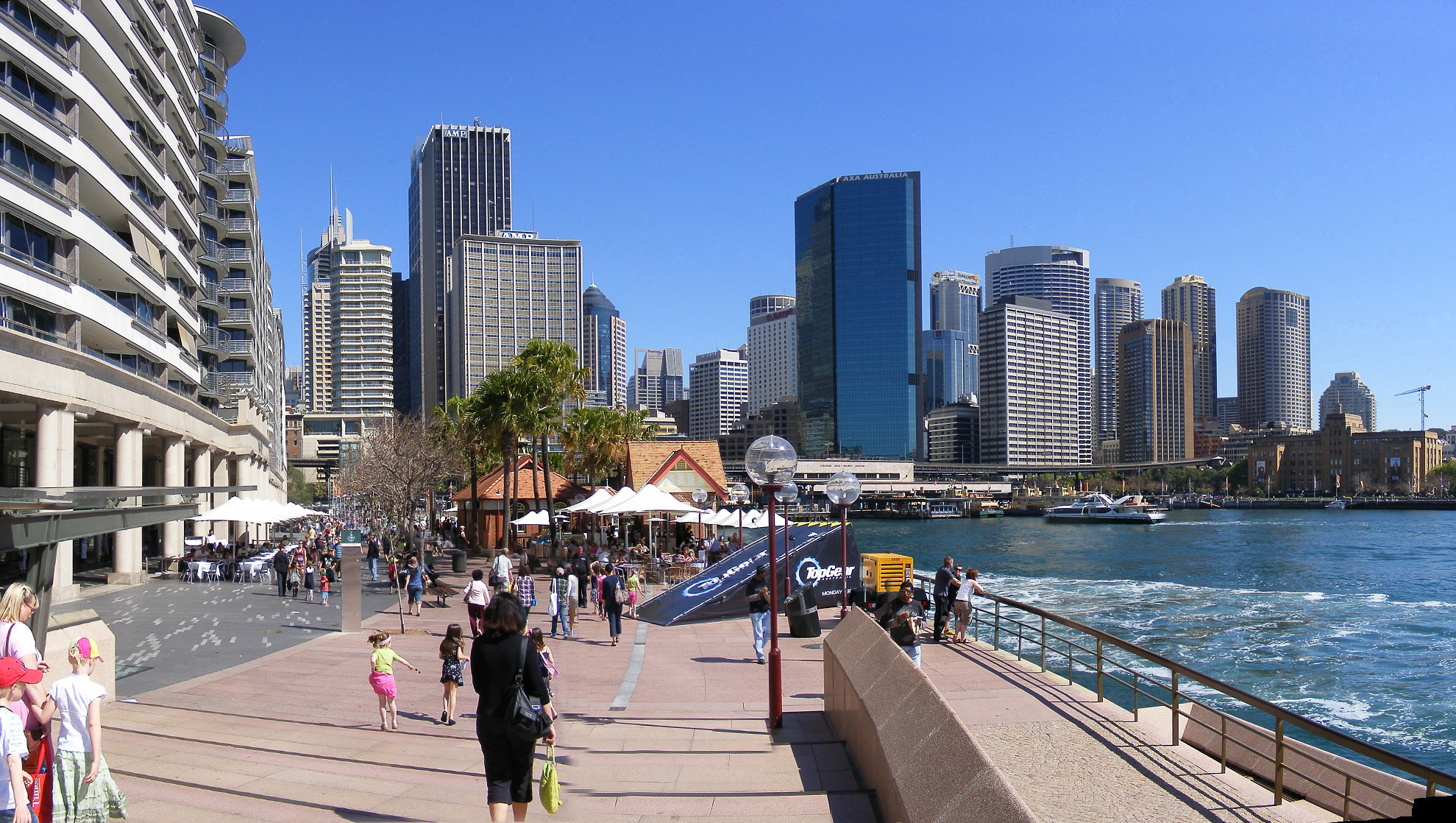|
Kurraba
''Kurraba'' and ''Kirribilli'' were two similar " K-class" ferries on Sydney Harbour. Launched in 1899 and 1900 respectively, the two timber-hulled steamers were built for Sydney Ferries Limited during the boom in cross-harbour ferry travel prior to the opening of the Sydney Harbour Bridge. When built, they were the largest of the cross-harbour ferries and brought new levels of comfort for passengers. They were the first true examples of what would come to be known as the "K-class" ferries - a group of 25 double deck, double-ended, predominantly timber-hulled (four later versions had steel hulls), screw ferries propelled by triple expansion steam engines. Built for, and initially used on, the short but busy cross-harbour route between Circular Quay and Milsons Point, they were also used frequently on the Mosman route. Along with 17 others, the two ferries were sold for breaking up in 1934 following the opening of the Sydney Harbour Bridge in 1932. Background Both ferries we ... [...More Info...] [...Related Items...] OR: [Wikipedia] [Google] [Baidu] |
Kurraba Point, New South Wales
Kurraba Point is a harbourside suburb on the lower North Shore of Sydney, New South Wales, Australia. Kurraba Point is located 4 kilometres north of the Sydney central business district, in the local government area of North Sydney Council. Kurraba Point shares the postcode of 2089 with adjacent suburb of Neutral Bay. It is bordered by Neutral Bay, Cremorne and Cremorne Point. History Aboriginal culture Prior to the arrival of the First Fleet, the area in which Kurraba Point is situated was inhabited by the Cam-mer-ray-gal Group of the Ku-ring-gai Aboriginal Tribe. The group, which inhabited the north shore of Port Jackson, was one of the largest in the Sydney area. The name "Karraba" or "Kurraba" is of aboriginal derivation and is thought to mean Hungry Bay or Shell Cove. European settlement On 2 May 1814, Kurraba Point was included in the 700 acre land grant that was given to Lieutenant Alfred Thrupp as a wedding gift. At that time the area, which included most of w ... [...More Info...] [...Related Items...] OR: [Wikipedia] [Google] [Baidu] |
Neutral Bay
Neutral Bay is a suburb on the Lower North Shore of Sydney, New South Wales, Australia. Neutral Bay is around 1.5 kilometres north of the Sydney central business district, in the local government area of North Sydney Council. Neutral Bay takes its name from the bay on Sydney Harbour. Kurraba Point, formerly a locality in Neutral Bay, was declared a separate suburb in 2010, sharing the postcode 2089. Surrounding suburbs include North Sydney, Cammeray, Milsons Point, Cremorne and Cremorne Point. History The name "Neutral Bay" originates from the time of the early colonial period of Australia, where different bays of Sydney harbour were zoned for different incoming vessels. This bay was where all foreign vessels would dock, hence the name ''neutral''. The Aboriginal name for the area was 'Wirra-birra'. In 1789, soon after the arrival of the First Fleet in Sydney, Governor Arthur Phillip declared this bay a ''neutral harbour'' where foreign ships could anchor and take on wate ... [...More Info...] [...Related Items...] OR: [Wikipedia] [Google] [Baidu] |
Sydney K-class Ferries
The K-class ferries were a group of double-ended screw steam ferries run by Sydney Ferries Limited and its government successors on Sydney Harbour. The company introduced more than two dozen of the vessels from the 1890s through to the early twentieth century to meet the booming demand for ferry services across Sydney Harbour prior to the opening of the Sydney Harbour Bridge in 1932. The K-names were largely Australian Aboriginal names with their meanings listed in the table below. Design The K-class were not a group of identical ferries - they were delivered in batches of two or three identical sister ships - rather they were a general type of vessel that ranged in sized but shared a typical form. They were all double-deck, double-ended screw steamers with two raised wheelhouses and a single tall funnel. Apart from a few early vessels with open upper decks that were later enclosed, the K-class had enclosed upper and lower saloons with lower deck outdoor seating around the vessel ... [...More Info...] [...Related Items...] OR: [Wikipedia] [Google] [Baidu] |
Koree
''Koree'' was a " K-class" ferry on Sydney Harbour. Launched in 1902, the timber-hulled steamer was built for Sydney Ferries Limited during the boom in cross-harbour ferry travel prior to the opening of the Sydney Harbour Bridge. When built, ''Koree'' was Sydney's largest cross-harbour ferry and a typical early example of the "K-class"; a group of double-deck, double-ended, steam-powered screw ferries. ''Koree'' was the first Sydney ferry built with the sides of her promenade (upper) deck enclosed, although the ends near the wheelhouses remained open. Built for, and initially used on, the short but busy cross-harbour route between Circular Quay and Milsons Point, ''Koree'' was also used frequently on the Mosman route. Along with 17 other Sydney Ferries Limited vessels, the ferry was sold for breaking up in 1934 following the opening of the Sydney Harbour Bridge in 1932. Background ''Koree'' was built for Sydney Ferries Limited during the early twentieth century boom in cross-Har ... [...More Info...] [...Related Items...] OR: [Wikipedia] [Google] [Baidu] |
Kirawa (ferry)
''Kirawa'' was a ferry on Sydney Harbour. She was a near identical sister vessel with '' Kanangra'' both of which were launched in 1912 during the early-twentieth pre-Sydney Harbour Bridge boom years of Sydney Ferries Limited. They were the first of four steel-hulled " K-class" ferries (the majority of the type were timber-hulled). At 45 metres in length and with passenger capacity of almost 1,000, and they were among the largest of the Sydney Ferries Ltd fleet. At launch, the press noted ''Kirawa'' was built for the then new Cremorne service, which was then run separately to the Mosman route. She would, however, soon also work the Mosman route with sister ''Kanangra''. ''Kirawa'' was decommissioned in 1953. Sister ''Kanangra'', however, was in passenger service until 1985 and is now part of the Sydney Heritage Fleet and is moored at Rozelle Bay undergoing restoration. Sydney Ferries Limited generally choose Australian Aboriginal names for the early twentieth "K-class" steamer ... [...More Info...] [...Related Items...] OR: [Wikipedia] [Google] [Baidu] |
Kosciusko (ferry)
''Kosciusko'' was a " K-class" ferry on Sydney Harbour. Launched in 1911, the timber-hulled steamer was built for Sydney Ferries Limited during the boom in cross-harbour ferry travel prior to the opening of the Sydney Harbour Bridge. ''Kosciusko'' was converted to diesel propulsion in the 1950s and served on Sydney Harbour until 1975 when she was sent to Hobart to assist following the collapse of the Tasman bridge. She was burnt out in 1982. Background Intended for the Mosman run, ''Kosciusko'' was built for Sydney Ferries Limited during the early twentieth century boom in cross-Harbour travel prior to the 1932 opening of the Sydney Harbour Bridge. At the time, the company ran one of the largest ferry fleets in the world. The ferry was part of broader type of around 20 double-ended timber screw ferries the Sydney K-class ferries that the company commissioned between the 1890s and early 1920s to meet the booming demand. While ''Kosciusko'' followed the Sydney Ferries ... [...More Info...] [...Related Items...] OR: [Wikipedia] [Google] [Baidu] |
Sydney Harbour
Port Jackson, consisting of the waters of Sydney Harbour, Middle Harbour, North Harbour and the Lane Cove and Parramatta Rivers, is the ria or natural harbour of Sydney, New South Wales, Australia. The harbour is an inlet of the Tasman Sea (part of the South Pacific Ocean). It is the location of the Sydney Opera House and Sydney Harbour Bridge. The location of the first European settlement and colony on the Australian mainland, Port Jackson has continued to play a key role in the history and development of Sydney. Port Jackson, in the early days of the colony, was also used as a shorthand for Sydney and its environs. Thus, many botanists, see, e.g, Robert Brown's ''Prodromus Florae Novae Hollandiae et Insulae Van Diemen'', described their specimens as having been collected at Port Jackson. Many recreational events are based on or around the harbour itself, particularly Sydney New Year's Eve celebrations. The harbour is also the starting point of the Sydney to Hobart Yacht ... [...More Info...] [...Related Items...] OR: [Wikipedia] [Google] [Baidu] |
Kirribilli, New South Wales
Kirribilli is a suburb of Sydney, New South Wales, Australia. One of the city's most established and affluent neighbourhoods, it is located three kilometres north of the Sydney central business district, in the local government area administered by North Sydney Council. Kirribilli is a harbourside suburb, sitting on the Lower North Shore of Sydney Harbour. Kirribilli House is one of the two official residences of the Prime Minister of Australia. History The name Kirribilli is derived from an Aboriginal word ''Kiarabilli'', which means 'good fishing spot'. Another theory suggests that Kirribilli is an adaptation of 'Carabella', the name given by early colonist James Milson to his first house. The suburb initially formed in the vicinity of Jeffrey Street and was subsequently part of a grant to James Milson (1785-1872), after whom Milsons Point was named. The area was largely covered in native bush. As the decades passed, the land was cleared bit by bit and sub-divided, first ... [...More Info...] [...Related Items...] OR: [Wikipedia] [Google] [Baidu] |
Kirribilli
Kirribilli is a suburb of Sydney, New South Wales, Australia. One of the city's most established and affluent neighbourhoods, it is located three kilometres north of the Sydney central business district, in the local government area administered by North Sydney Council. Kirribilli is a harbourside suburb, sitting on the Lower North Shore of Sydney Harbour. Kirribilli House is one of the two official residences of the Prime Minister of Australia. History The name Kirribilli is derived from an Aboriginal word ''Kiarabilli'', which means 'good fishing spot'. Another theory suggests that Kirribilli is an adaptation of 'Carabella', the name given by early colonist James Milson to his first house. The suburb initially formed in the vicinity of Jeffrey Street and was subsequently part of a grant to James Milson (1785-1872), after whom Milsons Point was named. The area was largely covered in native bush. As the decades passed, the land was cleared bit by bit and sub-divided, first ... [...More Info...] [...Related Items...] OR: [Wikipedia] [Google] [Baidu] |
Circular Quay
Circular Quay is a harbour, former working port and now international passenger shipping port, public piazza and tourism precinct, heritage area, and transport node located in Sydney, New South Wales, Australia on the northern edge of the Sydney central business district on Sydney Cove, between Bennelong Point and The Rocks. It is part of the local government area of the City of Sydney. The Circular Quay area is a popular neighbourhood for tourism and consists of walkways, pedestrian malls, parks and restaurants. It hosts a number of ferry quays, bus stops, and a railway station. Often referred to as the "gateway to Sydney", the precinct has views of the Sydney Harbour Bridge and the Sydney Opera House and is a common location for viewing Sydney New Year's Eve fireworks. History Indigenous history The Aboriginal name for Circular Quay is ''Warrung'', meaning "Little Child". The first people to occupy the area now known as Sydney were Aboriginal Australians. Radiocarbon da ... [...More Info...] [...Related Items...] OR: [Wikipedia] [Google] [Baidu] |
Sydney Ferry KURRABA At McMahons Point Following Collision With Ferry KIRRIBILLI 24 February 1932
Sydney ( ) is the capital city of the state of New South Wales, and the most populous city in both Australia and Oceania. Located on Australia's east coast, the metropolis surrounds Sydney Harbour and extends about towards the Blue Mountains to the west, Hawkesbury to the north, the Royal National Park to the south and Macarthur to the south-west. Sydney is made up of 658 suburbs, spread across 33 local government areas. Residents of the city are known as "Sydneysiders". The 2021 census recorded the population of Greater Sydney as 5,231,150, meaning the city is home to approximately 66% of the state's population. Estimated resident population, 30 June 2017. Nicknames of the city include the 'Emerald City' and the 'Harbour City'. Aboriginal Australians have inhabited the Greater Sydney region for at least 30,000 years, and Aboriginal engravings and cultural sites are common throughout Greater Sydney. The traditional custodians of the land on which modern Sydney stands are th ... [...More Info...] [...Related Items...] OR: [Wikipedia] [Google] [Baidu] |
Sydney Cove
Sydney Cove (Eora: ) is a bay on the southern shore of Sydney Harbour, one of several harbours in Port Jackson, on the coast of Sydney, New South Wales. Sydney Cove is a focal point for community celebrations, due to its central Sydney location between the Sydney Opera House and the Sydney Harbour Bridge. It is also one of the main congregation points for Sydney New Year's Eve. History The Eora name for Sydney Cove was recorded by several early settlers of the First Fleet variously spelt as Warrane, War-ran, Warrang and Wee-rong. The spot is of great significance, as the first meeting place between Eora people and Europeans. Before colonisation of the area, Eora men speared fish from the shoreline, and women line-fished from their ' (canoes). Sydney Cove was named after the British Home Secretary, the 1st Baron Sydney (who was later created 1st Viscount Sydney in 1789). It was the site chosen by Captain Arthur Phillip, RN between 21 and 23 January 1788 for the British p ... [...More Info...] [...Related Items...] OR: [Wikipedia] [Google] [Baidu] |







.jpg)


